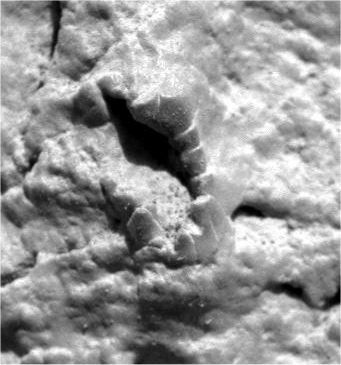
Negative image:

Normal image:

Negative image:

On sol 34, MER-B took this micrograph of an area of the rock outcrop before doing a RAT operation. The image was truely amazing. No explanation has been offered for this feature, other than that it is in fact a fossil. It appears to be a segmented, hollow, fosilized tube.
This feature was unfortunatley destroyed by a RAT operation imediately after it was discovered. The command sequence to take the image and then perform the RAT operation was probably sent at the same time, so MER-B may have actually continued with the pre-programmed command sequence before anyone on earth had seen this image.
This feature is vaguely reminiscent of a crinoid. If it is biogenic of course nothing is known about what the original organism was, so calling it a crinoid is not accurate at all. However, a crinoid is the closest terrestrial analogy we have to this fossil. To be more accurate, we should call it a crinoid-oid, something like a crinoid.
More than any other object imaged by either rover, this looks like a fossil. If it were found on earth, there would be no question. The image focus is clear. There is plenty of pixel resolution to see all the details. It has bilateral symetry. There is clear segmentation. It would be very difficult to explain the complexity of this feature without using biology. It meets all the requirements to be called a fossil, even according to the Knoll criterion.
If it looks like a duck, and it quacks like a duck, it is a duck.
If you wish to post a comment, just send me an email at
